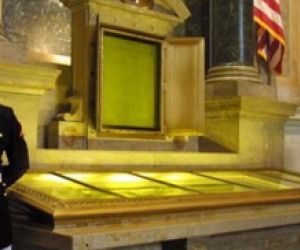James Madison On The Sidewalk

Faded but still legible, original copies of the Declaration of Independence, Constitution and Bill of Rights are enshrined at the National Archives. Created in the heat of a revolution that still inspires freedom around the world, the precious papers lie immersed in argon gas at a constant sixty-seven degrees and forty percent humidity. Documents that served as the rising sun of liberty are now fastidiously shielded from daylight, bathed in low-level protective lighting.
Your eyes take time to adjust from how bright it is outside, so you walk a little slower when you pass through the doors. You enter the rotunda and have a choice; start at the left and read your way clockwise to the right or head straight to what is apparently the most important document right in the middle. That document is the Constitution. It is flanked on the left by the Declaration of Independence and on the right by the Bill of Rights. That these are the real deal documents is as hard to fathom as why people haven’t dressed a little better to be in their presence.
Faith is a blend of what is visible and what is unseen, and unknown. You read the original words of life, liberty and pursuit of happiness and wonder if you lived in 1776, would you have been courageous enough to sign on. You study the blueprints of a new nation conceived in liberty and say a prayer for those who have given their full measure to protect rights too many take for granted. That the documents still exist is faith, made visible. Those things they taught in civics class are real.
We think of the First Amendment being special among amendments, in part, because it is first. Surely, the founding fathers placed freedom of speech, religion, assembly and the press first because these are the underpinnings of liberty? It is a conventional contemporary wisdom that is belied by historical fact. The first amendment was originally drafted as the third amendment in 1789. The originally proposed first amendment dealt with how many U.S. House representatives there should be and the second prohibited Congress from raising their pay without an intervening election. This originally proposed Second Amendment would take 203 years to be ratified, which says something about what they didn’t teach us in civics class. In any event, amendment number three became amendment number one. Just my opinion, but I think the nation is better for it.
It is a half continent from Washington, D.C. to Topeka, Kansas and nearly 225 years since freedom of speech and religion moved into first place on the Bill of Rights.
I’d like to report my first reaction to reading a letter from Westboro Baptist Church announcing their intention to conduct public demonstrations in Davenport was considered in accord with the reverence and repose of a constitutional scholar. But that would not be true. My first reaction to their request that DPD “fulfill their duty to take responsible steps to keep the peace” was incredulousness and clenched fists. There is a brutal elegance to a right cross putting an end to hate speech. But that would be wrong. Hate begets violence, and there is an inhuman amount of both in the world. We need none of either in Davenport.
The antidote to hate is love and understanding. Hate burns itself out, while love and understanding are as enduring as faith in the ideals of personal liberty guaranteed by the talismans under protective glass at the National Archives. An offensive sign bothers you? Ignore it, or make one of your own. Freedom only fades when it is not practiced.

